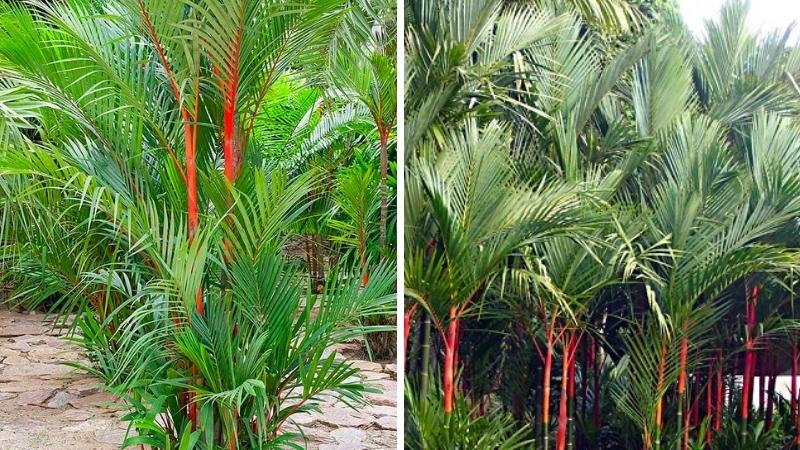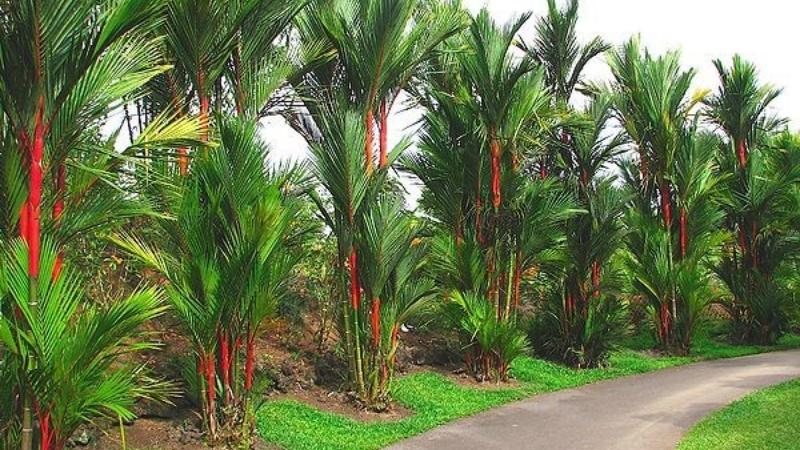The Cyrtostachys renda, or red palm, is a striking plant with vibrant red stems and lush green leaves, making it a popular choice for ornamental gardens. This article will explore the significance, cultivation, and care of this unique plant.
1 What is the Red Palm?
Origin and Significance of the Red Palm
The red palm, scientifically known as Cyrtostachys renda, is a member of the Arecaceae family native to Asia. In Vietnam, it is commonly referred to as the red palm leaf.
 What is the Red Palm?
What is the Red Palm?
Feng Shui Significance of the Red Palm
The striking red color of the red palm’s stems is associated with good luck and positive energy in Feng Shui. As such, this plant is believed to bring prosperity and good fortune to its owner.
The red palm is particularly suited to individuals with a Huo (Fire) element in Chinese astrology, as red is the representative color of this element. Additionally, as Huo generates Tu (Earth), individuals with either of these elements will find that the red palm brings harmony and positivity to their living or working space.
 Feng Shui Significance of the Red Palm
Feng Shui Significance of the Red Palm
Characteristics and Classification of the Red Palm
The red palm typically grows in large, rounded clumps, with bright red leaf sheaths encircling the stems in a visually appealing manner. It commonly grows to a height of 5-8 meters, occasionally reaching 10 meters.
Its leaves are pinnately compound, deep green in color, and can grow over 1.2 meters long, resembling a peacock’s tail. The flowers of the red palm grow in dense clusters from the leaf sheaths, featuring numerous small, hairy flowers that reveal white stamens when in bloom.
The fruit of the red palm is a hard, green drupe that matures to black when ripe.
 Characteristics of the Red Palm
Characteristics of the Red Palm
2 Benefits of the Red Palm
Aesthetic Benefits
Due to its impressive size and straight growth habit, the red palm is often used for shading and creating beautiful green spaces in parks, homes, and along pathways. It is also a popular choice for indoor decoration in large spaces such as hallways and atriums.
The red palm is also used to create striking landscapes when paired with white pebbles, adding a focal point to any space while enhancing its Feng Shui.
 Benefits of the Red Palm
Benefits of the Red Palm
Feng Shui Benefits
The red palm, with its distinctive red stems, is a symbol of good luck in Feng Shui. The color red, in this context, represents positive energy and prosperity for the homeowner. If you wish to bring good fortune to your loved ones, consider adding a red palm to your indoor space.
3 Cultivation and Care of the Red Palm
Growing the Red Palm at Home
The ideal time to plant red palms is during the months of March-April and August-October. Propagation can be done through seedlings or fresh seeds, with the latter taking 2-4 months to germinate, while dry seeds can take up to a year.
For seed germination, use well-aerated, moist soil with an overhead cover to retain moisture and protect from frost. The best time to sow seeds is towards the end of the year to avoid salt frost. Red palms thrive in nutrient-rich, well-drained, and aerated soil, avoiding waterlogging.
It is important to apply basal fertilizer and ensure the soil is not too deep, as this can hinder growth and branching. For potted plants, apply basal fertilizer before planting and ensure the plant is not buried too deeply to facilitate effective nutrient absorption.
 Growing the Red Palm at Home
Growing the Red Palm at Home
Caring for the Red Palm at Home
Soil: As mentioned, red palms thrive in nutrient-rich, well-drained, and aerated soil, avoiding waterlogging.
Light: Red palms thrive in bright, sunny conditions, but when young, they benefit from partial shade. Ensure mature plants are positioned in areas with ample sunlight to prevent poor growth and discoloration of the red stems.
Watering: Red palms require regular watering to maintain adequate moisture levels. However, ensure the soil drains well to prevent waterlogging.
 Caring for the Red Palm
Caring for the Red Palm
Temperature: Red palms do not tolerate extreme temperatures, whether too hot or too cold, but they can withstand flooding.
Pest Control: Red palms are generally resistant to pests, but they may be affected by tea scale insects, which lay eggs and feed on the leaves. To control this, remove affected leaves with eggs and spray the plant with soapy water and chemical pesticides.
Notes on Growing and Caring for the Red Palm
Ensure your red palm receives adequate sunlight, as insufficient light will result in poor growth and eventual death. Maintain consistent moisture in the soil and avoid allowing it to dry out.
Every two months, apply a liquid manure solution at a ratio of 1:15 to 1:20 to promote growth and maintain leaf health.
 Notes on Growing and Caring for the Red Palm
Notes on Growing and Caring for the Red Palm
The red palm is susceptible to pests such as green beetles, leaf rollers, soft scale insects, and spiders. If left untreated, these pests can reduce the vitality of the plant, so it is essential to use specialized agricultural pesticides to control their populations.
The red palm has large hanging panicles and a preference for moist conditions, so watering twice a day is recommended. If the plant experiences water stress, the stems will shrink at the neck, resulting in an unsightly, stunted appearance.
5 Beautiful Images of the Red Palm
 Beautiful Images of the Red Palm
Beautiful Images of the Red Palm
 Beautiful Images of the Red Palm
Beautiful Images of the Red Palm
 Beautiful Images of the Red Palm
Beautiful Images of the Red Palm
 Beautiful Images of the Red Palm
Beautiful Images of the Red Palm
 Beautiful Images of the Red Palm
Beautiful Images of the Red Palm
This article has provided an overview of the characteristics, significance, and cultivation of the red palm, along with tips for its care. We hope you found this information helpful and inspiring!






































